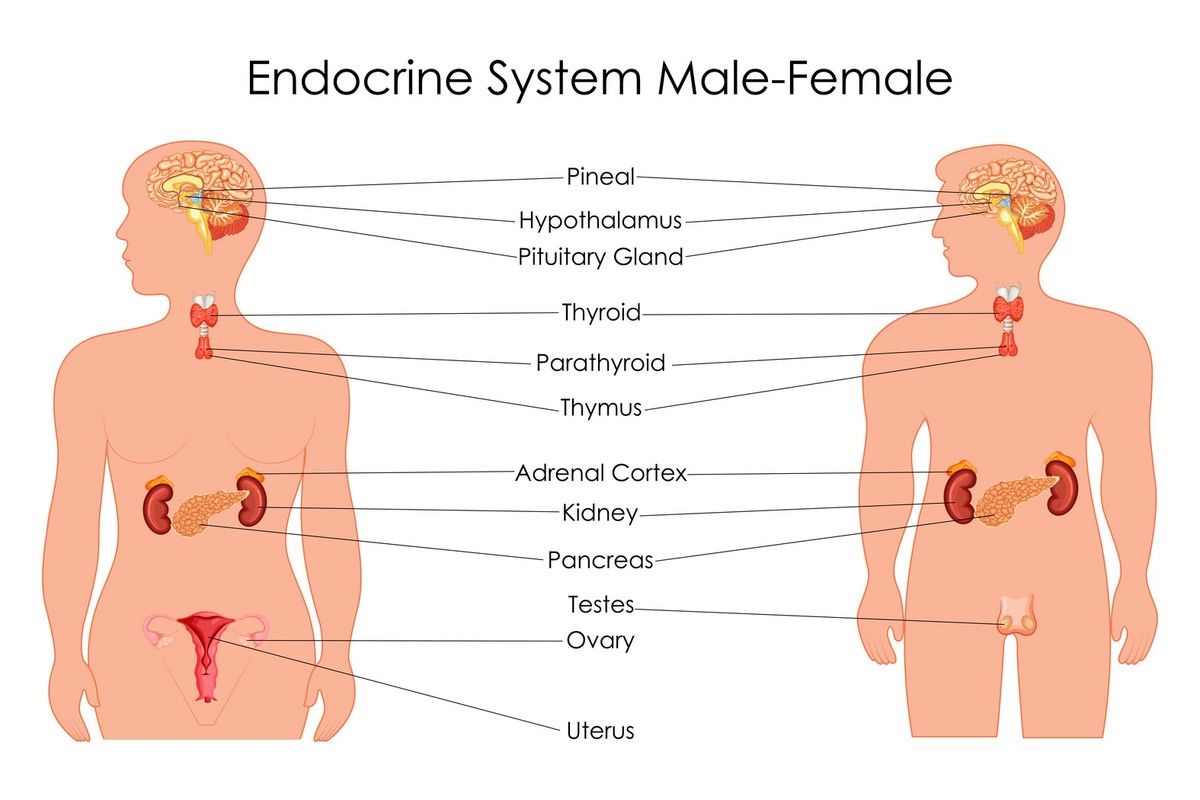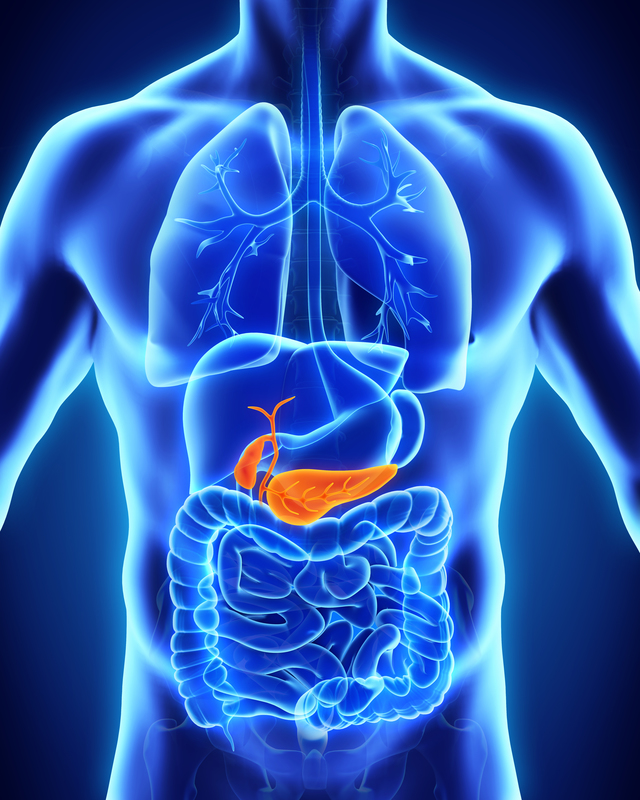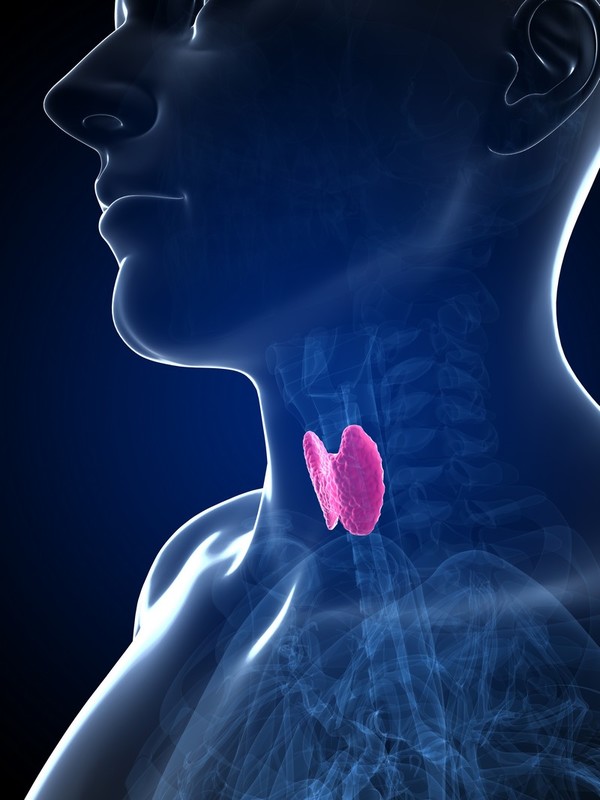11. Endocrine glands
Contents of the chapter
11.1 Hormones and endocrine glands
The human body operates with the help of two control systems. The nervous system collects, processes, and responds to information using electrical signals, whereas the endocrine system regulates cells and organs through chemical substances called hormones. Together, the two systems control the functions of the human body.
The chemical substances secreted by the endocrine glands circulate through the body in blood. Endocrine glands are ductless glands that secrete their products, hormones, directly into the blood. There are about a dozen different endocrine glands in various parts of the body, many of which secrete several hormones. In addition, the liver and heart are also capable of producing hormones.
Hormones are chemical substances that affect the activity of another part of the body, known as the target site. In essence, hormones serve as messengers, controlling and coordinating activities throughout the body. They can speed up or slow down the functions of the organs. The effects of hormones are slow and long-lasting.
As the hormone levels in the body increase, the secretion of hormones gradually decreases due to negative feedback. This keeps your body in balance. If too much or too little hormone is secreted, the end result may be a hormone-related illness.
The location of the endocrine glands is shown in the diagram below. The pineal gland, which is not introduced separately in the text below, secretes melatonin into the blood. Melatonin is involved in controlling the circadian rhythm.
| Hormone and secretory body | Effect |
|---|---|
| melatonin, pineal gland | Regulates the sleep-wake rhythm. The secretion increases in the dark. Facilitates falling asleep, regulates circadian rhythms. |
| thymosin, thymus | Stimulates the maturation of T lymphocytes (white blood cells) (thymus). |
11.2 The pituitary gland
The pituitary gland weighs about half a gram and is located below the cerebrum. Despite its size, it plays a very important role in the regulation of the body's functions.
Many of the hormones secreted by the pituitary gland affect the body's functions, as well as the functions of other endocrine glands. In turn, it is regulated by the brain's hypothalamus, which secretes hormones that cause the pituitary gland to increase or decrease its own hormone production.

The growth hormone (somatotropin, HGH) secreted by the pituitary gland is one of the factors that influence an individual's growth together with the hormones secreted by the thyroid gland and gonads. The growth hormone regulates bone growth as well as the production of proteins, which is important for the functions of cells and tissues.

The human growth hormone (HGH) influences height.
If HGH is not secreted sufficiently during an individual's growth period, the person will gain a short stature. Conversely, the excessive secretion of HGH causes excessive growth. The reason for excessive hormone secretion is usually a tumour located either in the hypothalamus or elsewhere in the brain. Excessive secretion may also counteract the effects of insulin.
Excessive secretion in adulthood usually results in hypertrophy of the extremities of the body, such as the feet or palms. Unlike thyroxine secreted by the thyroid gland, HGH has no effect on mental growth.
| Hormone | Effects |
|---|---|
| thyrotropin (TSH) | thyroid function |
| follitropin (FSH or follicle stimulating hormone) | gonads: gametes production |
| lutropin (LH or lureinizing hormone) | gonads: testoterone |
| prolactin | secretion of milk |
| corticotropin | adrenal cortex |
| growth hormone (GH or somatropin) | in tissue metabolism and growth |
| Hormone | Effects |
|---|---|
| oxytocin | e.g. labor contractions and relaxation of the mammary glands |
| ADH (antidiuretic hormone) | concentrates urine by regulating water in the body |
11.3 The pancreas
The pancreas is located in the upper abdomen behind the stomach. It weighs about 100 grams. The pancreas is both an endocrine and exocrine gland, because it secretes both hormones and digestive enzymes.
The digestive enzymes secreted by the exocrine portion of the pancreas break down nutrients in the duodenum, the first part of the small intestine.
The endocrine portion of the pancreas secretes its hormones into the blood stream. Your pancreas produces insulin and glucagon, two hormones that regulate the blood's sugar levels. Insulin and glucagon are secreted from your pancreas directly into your blood.
The carbohydrates that are part of your diet are digested and converted into glucose. Glucose is the main source of energy for cells, especially in the brain.
Some hormones secreted by the pancreas increase the levels of glucose in the blood. Insulin enhances the uptake of glucose into cells.
As blood flows through the pancreas, it regulates the amount of insulin secreted by the pancreas, thereby keeping the blood sugar level steady. Insulin is a hormone that helps to move sugar, or glucose, into your body's tissues. If insulin secretion is insufficient, the body's blood sugar levels will increase.
This causes the sugar to be excreted in the urine. The person has diabetes. Initial symptoms include thirst, tiredness and increased urination.
 Lack of insulin causes diabetes. Injections of insulin can help treat diabetes. Insulin cannot be administered as a tablet because it is a protein.
Lack of insulin causes diabetes. Injections of insulin can help treat diabetes. Insulin cannot be administered as a tablet because it is a protein.
Signs of an advanced disease include weight loss and a smell of acetone in the breath: in the absence of glucose, the body begins to draw energy from adipose tissue. The person's personality may also change due to lack of glucose in the brain.
There are two types of diabetes: type 1 diabetes, once known as juvenile diabetes, is treated with insulin. However, exercise and diet may be sufficient to treat type 2 diabetes, formerly known as adult-onset diabetes. Diabetes is considered a major public health problem worldwide.
| Endocrine gland | Hormone | Effects |
|---|---|---|
| pancretic | insulin | increases the uptake of glucose from the bloodstream into cells (i.e., lowers blood sugar levels) |
| pancreatic | glucagon | increases hepatic glucose production and blood flow |
11.4 The thyroid gland
Our largest endocrine gland, the thyroid gland, resembles the shape of a butterfly wing. It is located in the front of the trachea near the larynx, and the hormone it secretes, thyroxine, is the most important hormone that affects the body's overall metabolism. In youth, it also regulates the individual's growth and development. Its secretion into the blood stream accelerates the body's basic metabolism, such as the burning of fats and the absorption of nutrients from the intestine.
A hyperactive (overactive) thyroid gland can double the rate of the body's basic metabolism. Typical symptoms include weight loss despite increased appetite, sweating, shaking of hands, puffiness of the eyes and a rapid or irregular heartbeat. It is a more serious and rare disease, but it can also be treated with medication or surgery.
Thyroid inflammation is a common cause of hypothyroidism (underactive thyroid). Symptoms include fatigue, increased need for sleep, weight gain and even depression. Hypothyroidism is usually treated with thyroxine pills. Both conditions are more common in women than in men.
The function of the thyroid gland is to take iodine, found in many foods, and convert it into thyroid hormones. If a person does not gain enough iodine in their diet, this can cause an abnormal enlargement of the thyroid gland, known as a goiter, and other thyroid problems. This common condition has been greatly reduced by adding iodine to table salt.
If too little thyroxine is excreted during childhood, the consequences can be fatal. The child's physical and mental growth are impaired, which may lead to problem's with the person's mental and physical development.
11.5 Adrenal glands
The adrenal glands are pyramid-shaped glands which, despite their small size, are very important for the body's functions.
One adrenal gland sits on top of each kidney. They are, however, not involved in any way in the function of the kidneys.
Each adrenal gland is composed of two distinct parts: the outer part called the adrenal cortex and the inner part adrenal medulla. The hormones they release have quite different functions.
The adrenal medulla produces adrenaline and noradrenaline. These hormones are responsible for all the physiological characteristics of the stress response, also known as the 'fight or flight' response. These hormones increase the heart rate, direct blood into the muscles, improve oxygen intake and raise blood sugar levels. The muscles, the brain and the heart will then function rapidly. If the levels of these hormones are constantly high due to mental strain, the result can be a permanent state of stress, which is harmful to the body.
The adrenal cortex produces a variety of hormones that regulate the correct levels of sugars, salts and calcium in the body.
One such hormone is cortisol, which stimulates glucose production. It is also an important stress hormone, because it regulates the sleep-wake rhythm.
| Endocrine gland | Hormone | Effect |
|---|---|---|
| adrenal cortex | mineralocoricoids | Affect the metabolism of minerals. For example, aldosterone increases the function of the cellular sodium pump in the kidney. |
| adrenal cortex | glucocoricoids | Affect glucose metabolism. For example, cortisol affects hepatic glucose production → blood glucose increase. |
| adrenal medulla | adrenaline and noradrenaline | Increase physical performance. For example, adrenaline raises blood pressure. |
11.6 Gonads or sex glands
 The gonads (testes in males and ovaries in females) are responsible for the production of gonadal/steroid hormones. The gonads, also called sex glands, are activated during puberty by the hormones secreted by the pituitary gland. After this, they begin to produce sex hormones and sex cells.
The gonads (testes in males and ovaries in females) are responsible for the production of gonadal/steroid hormones. The gonads, also called sex glands, are activated during puberty by the hormones secreted by the pituitary gland. After this, they begin to produce sex hormones and sex cells.
The most important steroid hormone secreted by the ovaries is estrogen, which controls the development of female secondary sexual characteristics. Similarly, in boys, testosterone produced by the testes controls the development of male secondary sexual characteristics, including muscle growth. This is the reason why artificial male hormones are used as doping agents. However, both sexes secrete both hormones, and the relative amount of both hormones in relation to each other is important.
In addition to sexual development, sex hormones affect the individual's height. There are also major changes in the frontal lobe of the brain, affecting a person's mental development.
| Endocrine gland | Hormone | Effects |
|---|---|---|
| ovaries | estrogen | Development of secondary sexual characteristics of a woman. Menstrual cycle, maintenance of uterine and mammary gland function. |
| ovaries | progesterone | Menstrual cycle and maintenance of pregnancy |
| testes | testosterone | Development of secondary sexual characteristics of a man. Sperm formation. Accelerates metabolism (anabolism). (Testosterone is also produced in the adrenal glands and in the ovaries). |



